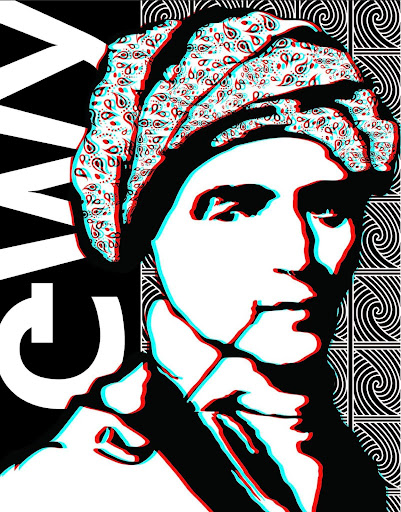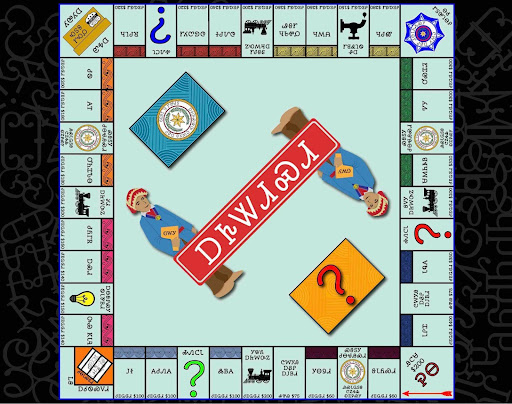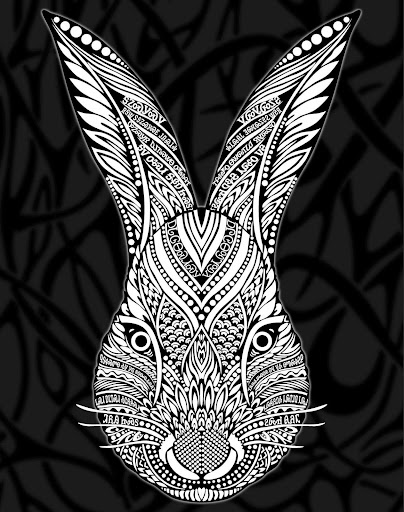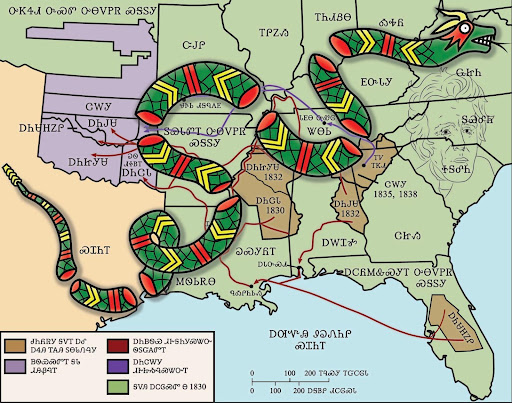Sequoyah © Jeff Edwards
By Celestine J. Epps
Published first in the Blue Banner, UNCA
“A Living Language” exhibition celebrated recently the cultural and national identity of artists from the Eastern Band of the Cherokee Indian (EBCI) in downtown Tokiyasdi / Asheville, NC. The curated works on display at the Asheville Art Museum consisted of over 50 multimedia pieces by EBCI artists who direct audiences’ attention to the Cherokee syllabary.
Their artwork defies the bias that Indigenous languages are dead by uplifting local Indigenous creators who help to restore the language. A variety of compositions such as Rachel Foster’s stone-polished ceramic “Sequoyah,” show traditional representations of Tsalagi, or Cherokee, in cultural artifacts like pottery and basket-weaving. Likewise, the graphic designs of Jeff Edwards puts on a prideful display of the syllabary, and inspires viewers to want to learn how to speak it. His piece “Tsalagiopoly” is delightfully shocking.
The syllabary was invented by a Cherokee man named Sequoyah in the early 19th-century who translated the 4000-year-old language into visual symbols and the written form we know today.
Tsalagiopoly © Jeff Edwards
Edwards is also a Language Technology Specialist for the Cherokee Nation in Tahlequah, Oklahoma. He contributes to the language education in schools and ensures that students are equipped with the technology needed to be successful. In 2010, the artist worked with fluent speakers to integrate Tsalagi into system keyboards on devices including Apple, Android, Microsoft, and Google
Edwards says: “What started our 10+ years of working with tech companies is we wanted our kids to be able to text in Cherokee. That was it. Nothing more. So, we worked with Apple for about 18 months and once the technology came available we saw something we didn’t expect. Our elders also took advantage of the technology. So not only were our students and elders communicating but they were also communicating with each other.”
Trickster © Jeff Edwards
Upon completion of the keyboard, Edwards explains the labor involved in translating entire operating systems and its impact on Cherokee people throughout the diaspora:
“So, when we started translating Windows 8 we had 18 months to complete the project. We had the 5 regular employees and some contract translators that were from various communities. We would receive 500-1000 words a day, I would do my thing, split them up evenly amongst the available translators, email the project out and when they finished they would send them back, I would submit and we continued this for 18 months with very little breaks. It is tough to say how many words were translated. It was well over the 300,000 range. But once the project was completed Microsoft in North America recognized two languages, English and Cherokee.”
Despite the nation’s success in making Tsalagi accessible on major platforms, they were forced to stop working with tech companies due to the endangered state of the language. There are only 176 people still living in the Eastern Band who grew up speaking Tsalagi and an estimate of 2,000 speakers left in the United States. Thus, prioritizing second-language speakers in tribal communities.
“A Living Languages” exhibit lived up to its name in its selection of pieces from Cherokee artists across generations. While navigating his busy schedule, Edwards continues to make original graphics. His latest piece, “Relocate, and/or Die” drew inspiration from Benjamin Franklin’s political cartoon intended to unite the colonies during the Revolutionary War.
Relocate and/or die © Jeff Edwards
Edwards explains: “My piece is made on a backdrop of a map of the Trail of Tears and the routes taken in Cherokee. My Uktena is cut into 8 pieces to represent the 8 states the tribes traveled through during removal and the Uktena has 5 buttons on his rattle to represent the 5 tribes that were forcibly removed from their homelands.”
“Anger can be a very good motivator.”
Ultimately, what inspires Jeff Edwards the most is bringing the syllabary to the spotlight.
“I try to showcase something that all Cherokee’s are proud of, our writing system.”
After seeing the exhibition multiple times, I was immediately drawn to Edwards’s work, especially “Tsalagiopoly.” Upon first glance, I recognized the similarity to the game Monopoly, and all that it represents in our western capitalist society.
Edwards’s intricate designs and sole use of Tsalagi communicate to a specific audience that is uniquely Indigenous. I believe his piece speaks volumes to first and second-language speakers. To participate in the game, you have to be able to understand the rules, but Tsalagiopoly breaks one’s expectations. With the syllabary as the centerpiece of his work, non-Tsalagi speakers like myself are stuck at collecting $200, incapable of moving forward.
The longer I examine the artwork, the more I wish to comprehend the nuggets of history, and cultural references embedded in the cards I imagine in the community chest space. Like anger, ignorance is a great motivator to understanding the language of the land that I stand on.
More About Jeff Edwards
- At the Asheville Art Museum: https://www.ashevilleart.org/work-of-the-week/digital-works-by-jeff-edwards/
- “Edwards Incorporates Cherokee Language in Artwork”, Will Chavez. Cherokee Phoenix Newspaper, 2021.
About Celestine J. Epps

Celestine J. Epps was born in Bronx, New York, on April 16, 2000. She is studying Mass Communication at the University of North Carolina at Asheville, and is currently the assistant Arts and Features Editor at the Blue Banner. She enjoys learning about global Indigenous communities, including the Haliwa-Saponi near her grandmother’s hometown. Upon graduation, Celestine would like to write about her conversations with Indigenous storytellers and the impact of their artistry across generations.
Bringing the Cherokee Syllabary to the Spotlight, Jeff Edwards © Celestine J. Epps - Siwar Mayu, April 2022




